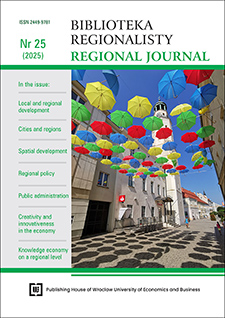Design for Deconstruction (DfD) in Urban Context: Recommendations for Cities
DOI:
https://doi.org/10.15611/br.2025.1.03Keywords:
designing for deconstruction (DfD), circular architecture, circular urbanism, spatial planningAbstract
Aim: The article aims to explore the feasibility of transferring the principles of designing buildings for deconstruction (DfD) to the urban scale and to develop practical recommendations for local authorities.
Methodology: The research methodology includes a literature review, desk research, comparative analysis, analogy, and synthesis.
Results: The study's findings result in recommendations supporting DfD-oriented urban planning, encompassing spatial planning, standardization of technologies and materials, data management, the promotion of DfD principles, and strategic development.
Implications and recommendations: The implications of the analysis highlight the need for a systematic integration of DfD principles into urban policy and planning practice. It is recommended to develop regulatory, educational, and digital tools that facilitate the implementation of DfD at the city scale and enhance awareness and engagement among all stakeholders.
Originality/value: The DfD principles, previously applied primarily in the architectural context of individual buildings, have been analyzed to adapt them to urban-scale applications, addressing the need to optimize and coordinate fragmented and independent design processes. This adaptation can facilitate the closure of material loops in specific urban areas, thereby advancing circular urbanism.
Downloads
References
Addis, B. (2006). Building with Reclaimed Components and Materials: A Design Handbook for Reuse and Recycling. Routledge.
Akinade, O. O., Oyedele, L. O., Ajayi, S. O., Bilal, M., Alaka, H. A., Owolabi, H. A., Bello, S. A., Jaiyeoba, B. E. i Kadiri, K. O. (2017). Design for Deconstruction (DfD): Critical Success Factors for Diverting End-of-Life Waste from Landfills. Waste Management, 60, 3-13. https://doi.org/10.1016/j.wasman.2016.08.017
Buda, S. (2006). Dynamika analogii. Zagadnienia Filozoficzne w Nauce, (38), 127-141.
Caro, D., Lodato, C., Damgaard, A., Cristóbal, J., Foster, G., Flachenecker, F. i Tonini, D. (2024). Environmental and Socio-Economic Effects of Construction and Demolition Waste Recycling in the European Union. Science of The Total Environment, 908, 168295. https://doi.org/10.1016/j.scitotenv.2023.168295
CIRCuIT. (2023). Circular Construction In Regenerative Cities: Insights from the CIRCuIT project.
CIRCuIT. (2025). Circuit. https://www.circuit-project.eu/about
Crowther, P. (2005). Design for Disassembly – Themes and Principles. Environment Design Guide, 1-7. http://www.jstor.org/stable/26149108
Derikvand, M. i Fink, G. (2023). Design for Deconstruction: Benefits, Challenges, and Outlook for Timber–Concrete Composite Floors. Buildings, 13(7), 1754. https://doi.org/10.3390/buildings13071754
Dyrektywa Parlamentu Europejskiego i Rady 2008/98/WE z dnia 19 listopada 2008 r. w sprawie odpadów oraz uchylająca niektóre dyrektywy, Dz. U. UE. L. 2008.312.3
Eurostat. (2024). Waste statistics. Europa.Eu. https://ec.europa.eu/eurostat/statistics-explained/index.php?title=Waste_statistics
Global Alliance for Buildings and Construction. (2024). Global Status Report for Buildings and Construction (No. CLI/2621/NA, 2024). United Nations Environment Programme.
Główny Urząd Statystyczny. (2024). Ochrona środowiska 2024.
International Organization for Standardization. (2020). ISO 20887:2020.
Kanters, J. (2018). Design for Deconstruction in the Design Process: State of the Art. Buildings, 8(11), 150. https://doi.org/10.3390/buildings8110150
Kręt-Grześkowiak, A. i Baborska-Narożny, M. (2023). Guidelines for Disassembly and Adaptation in Architectural Design Compared to Circular Economy GoalsA Literature Review. Sustainable Production and Consumption, 39, 1-12. https://doi.org/10.1016/j.spc.2023.04.020
Lakhouit, A. i Shaban, M. (2024). Exploring Sustainable Solutions with Machine Learning Algorithms: A Focus on Construction Waste Management. Clean Technologies and Environmental Policy, 1-14. https://doi.org/10.1007/s10098-024-02925-9
O’Grady, T., Minunno, R., Chong, H.-Y. i Morrison, G. M. (2021). Design for Disassembly, Deconstruction and Resilience: A Circular Economy Index for the Built Environment. Resources, Conservation and Recycling, 175, 105847. https://doi.org/10.1016/j.resconrec.2021.105847
Pristerà, G., Tonini, D., Lamperti Tornaghi, M., Caro, D. i Sala, S. (2024). Taxonomy of Design for Deconstruction Options to Enable Circular Economy in Buildings. Resources, Environment and Sustainability, 15, 100153. https://doi.org/10.1016/j.resenv.2024.100153
Roxas, C. L. C., Bautista, C. R., Dela Cruz, O. G., Dela Cruz, R. L. C., De Pedro, J. P. Q., Dungca, J. R., Lejano, B. A. i Ongpeng, J. M. C. (2023). Design for Manufacturing and Assembly (DfMA) and Design for Deconstruction (DfD) in the Construction Industry: Challenges, Trends and Developments. Buildings, 13(5), 1164. https://doi.org/10.3390/buildings13051164
Tingley, D. D. i Davison, B. (2011). Design for Deconstruction and Material Reuse. Proceedings of the Institution of Civil Engineers - Energy, 164(4), 195-204. https://doi.org/10.1680/ener.2011.164.4.195
Tomaszewska, J. (2020). Polish Transition towards Circular Economy: Materials Management and Implications for the Construction Sector. Materials, 13(22), 5228. https://doi.org/10.3390/ma13225228
Williams, J. (2019). Circular Cities. Urban Studies, 56(13), 2746-2762.
Downloads
Published
Issue
Section
License
Copyright (c) 2025 Tomasz Broma

This work is licensed under a Creative Commons Attribution-ShareAlike 4.0 International License.
Accepted 2025-02-28
Published 2025-06-27







